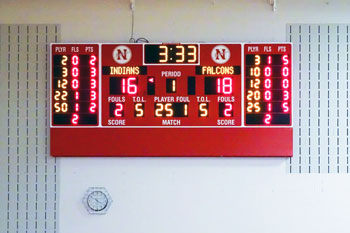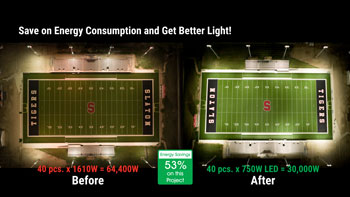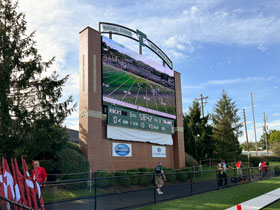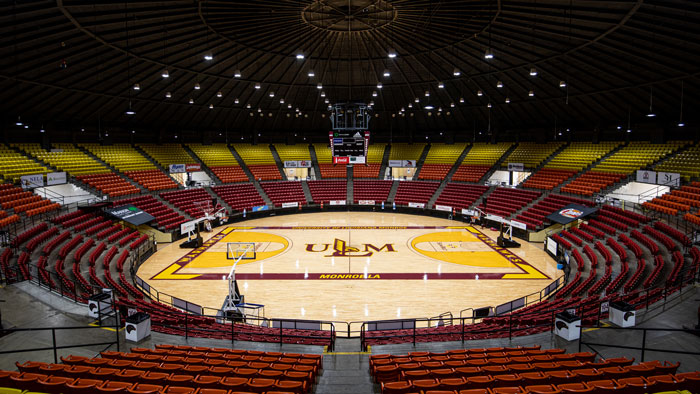Significant advances in visual, sound and lighting technologies are allowing outdoor stadium and arena operators to find and develop creative ways to enhance the gameday experience and engage spectators—be they sports fans or concert-goers, if the facility also serves that purpose.
Even more impressive, say manufacturers of light, sound and visual equipment, is the trend to make these sophisticated technologies more user-friendly, easy almost to the point of being turnkey, and customized to a client’s individual needs.
Score!
“Where would professional stadiums be without a video scoreboard?” asked Kyle Sydow, who specializes in the high
school and recreation market for a scoreboard manufacturing company based in Brookings, S.D.
The number one thing that teams want to do is build a connection or make an experience for fans, Sydow said. “And that is something modern scoreboards allow them to do by providing views that they don’t get, and providing them ways to interact with the team and the rest of the crowd. All of this is done through an AV system, which is the LED display that is in that facility.”

This has allowed teams to build a connection with the community, whether it’s a high school, college or pro team. The connection is what everybody is aiming for—to have the community rally behind a certain group for a certain cause, Sydow said.
“Attendees at sports and entertainment events have come to expect replays, closeups and an entire array of bells and whistles, such as video displays, professional lighting and sound as an added element to their entertainment experience,” said Jody Huntimer, marketing manager and a co-worker with Sydow in the high school, park and recreation space. “In the case of digital scoreboards, information can be provided and updated as the action on the field happens.”
From the technology side of things, there are trends at all levels, high school and up, such as LEDs on video boards getting closer together and tighter resolution.
It’s not enough to just have a video display anymore. Customers want the best, Huntimer said. They want something that shows that fine detail, where the screen doesn’t look like a video board. It looks more like a TV image quality.
Sydow agreed. “It’s kind of a proven path that tighter pixels, pitch, displays, high resolution, bigger displays are just common. More signage. More display opportunities are coming to light. Whether it is in the bowl or outside of the bowl, in concourse areas. That is where we are going—making it an all-encompassing digital experience, from the streets to your seat and back.
“Facilities always try to impress and make their community proud,” Sydow added, “and that’s what drives innovation: bigger, brighter, better.”
Depending on what someone wants to do with their content, “the sky’s the limit,” Huntimer said, “and I’m sure, eventually, artificial intelligence will become a part of it. Right now, the trend is just a ramping up of creativity that results from new technologies being installed. Scoreboards are getting more unique in shape and the way that they install them, locating displays throughout facilities. Placement has become more customized now than it has been in the past.”
Scoreboards are moving beyond the surface of play, the courts or the field and they are getting into locker rooms, into bar areas, hospitality areas and beyond. “We are seeing a proliferation of displays expanding throughout a facility versus just in the sporting area,” Huntimer added.
Another innovation incorporates a graphic representation of the ABS (automated ball-strike) system for use in video as part of the gameday presentation, explained Justin Ochsner, a colleague of Huntimer, specializing in college and pro sports. A control system can integrate the ABS system to share graphics in the video display.
But despite all their bells and whistles, one of the biggest trends in scoreboards is user-friendliness. “If we start at the high school level,” said Huntimer, “the biggest trend is that scoreboards are getting easier to run, more user-friendly. There are apps that you can download onto a tablet or a mobile phone you can use to run the scoreboard.”
She added that videoboards have seen an expansion of their utility beyond mere entertainment. “For a time, we viewed videoboards strictly as entertainment, and that was an expense the school needed to encourage to entertain their fans at sporting events. But now, in grades K-12, we are seeing an investment in educational opportunities with videoboards.”
An added bonus for secondary school administrators is that “we were able to show them that students can work displays and there is a career in that if they so choose,” Huntimer said. The CTE (Career Technical Education) classes schools are offering “…appear well-suited to videoboards because the students are learning production aspects, design and even sports marketing sponsorships.”

Students might work with local businesses to put their commercials on the videoboard. Or they could put together a sponsorship package for that business. “It’s even getting to the point where entire classes are dedicated to videoboard production, and producing sporting events,” Huntimer explained, adding that this approach has other benefits. “This gets kids who are typically not the athletes into the event, where running the videoboard is their event, where they are kind of competing, and it is just another avenue to get kids involved,” she said.
The skills developed running the scoreboard and videoboard can carry over into post-secondary life. If a high school student with that kind of experience chooses to go to college and wants to run videoboards in college, they will already have that base knowledge of how to do that. “Colleges are actively seeking people who have videoboard experience,” Huntimer said. “If it is a student, the school will already have someone who knows how to operate the board and it becomes a more complex or dynamic show than it was at the high school level.”
The talent and creativity Huntimer has noticed at the high school level “is just unbelievable and so exciting. To see students taking pride in putting on a show and having the crowd look at the display and react to the ‘Get Louder’ animation or a replay is a great feeling.”
Lights Fantastic
Lighting is an easily overlooked aspect of sporting events, said Nathan Davis, marketing director at a sports lighting
company based in Charlotte, N.C. “Yet light quality can make or break the experience for fans and athletes. Inadequate, low-quality lighting jeopardizes player safety, lowers the overall performance of athletes, damages the venue’s brand, holds back energy efficiency and inflates the venue’s overhead,” Davis said.
High-quality, efficient stadium lighting is a relatively new development in the industry. Up until around 2013, metal halide and high-pressure sodium lighting solutions dominated sports stadiums of all sizes, Davis said. But with the rise of LED’s popularity, sports stadiums have new options to enhance the viewer experience.
“Lighting solutions enable operators to remotely program, update and customize and control lighting systems, modifying aspects like color temperature or output beam control as an event requires,” Davis explained.
Lighting is critical to any sporting event, and trending technologies are improving the visual experiences of spectators. “Lighting has evolved not only through the adoption of more energy-efficient solutions such as LED lighting, but also through more efficient ways to control those light sources as well, explained Shahil Amin, vice president of sales and marketing for the sports lighting company in Charlotte, N.C. “Lights can now run off wireless controls that allow you to schedule events up to a year in advance and around the timing of your events, to make the most efficient use of your energy consumption.”
Where are the innovations in lighting? Along with more controls, LED lighting has allowed the reintroduction of color, Amin said. “More and more fields are adapting innovative RGBW/RGBA color solutions to showcase their facilities (and teams). These fixtures can also be paired up nicely with any sound systems to really drive the entertainment side of the sporting event.”
One of the key factors in figuring out what approach to take in lighting a field is really homing in on what the customer wants, Amin explained. “Many times, most customers don’t necessarily know what they need (in regard to new technology), so they use a basis of design presented when legacy (HID) technology was used. However, with more efficient technology, we are able to customize the design of the project, and present situations in which not only would we be able to use less energy, but overall fewer fixtures, and provide them with better quality of illumination.”
Sound Advice

Remember when a PA system consisted of an amplifier in a box and a speaker, a microphone with a cable on it? To get full coverage, you needed to make the system mobile so that a cheer squad and the marching band could move it around to different sections as needed.
Glenn Busse, vice president, sales and marketing, for an audio equipment manufacturer headquartered in Woodway, Texas, recalled those early days and how his company got started building sound systems that were portable and had microphones. “We made stuff that
was rough and tough and durable. We started selling mostly to schools, who used our systems at football
fields in 1973.”
Trends and innovations in audio systems have been aided by modern, evolving technologies, Busse said. Early on, systems were wired. “You had multiple units and they had to be wired together. The big step forward was to being totally portable and untethered,” he explained.
“Trends in the audio business are really all about one word: wireless,” Busse said. “That’s what we see as we focus on parks and recreation, outdoor sports, athletics.
“We’ve been dealing in a wireless world for decades now. But wireless means different things to different people. There are different technologies, and it is evolving constantly. That’s part of the benefits: technology evolves.”
You can take wireless outdoors or indoors, Busse said. “It has to be fast to deploy. You need to be able to cover an area.”
Those are the two rules for sound: fast deployment and effective coverage, he added.
As with lighting and scoreboards, user friendliness is crucial for providing sound on gameday. “I think that is one of the things that scares people a lot,” Busse said. “You have to keep it simple. You can’t have 25 different dials. There might not be a technician available to deal with this. You shouldn’t have to plug things in, connect things between each other.”
Wireless has a couple of dimensions, if you think about what you need to connect, Busse explained. “We talk about being cable-free. But wireless can get confusing. When you say wireless as it relates to sound systems, people usually think about a microphone.”
But wireless capabilities go beyond that, to allow, for example, wireless volume control via a phone or tablet. And on top of that, different parts of the system can be connected wirelessly.
“That’s a wireless trifecta, so to speak,” Busse said. That technology is evolving to where we want to make our systems meaner, leaner and faster and better.
“Our focus is to leverage the technology of wireless in the different areas for the different applications and have them work well together, and that is the part that some folks don’t always get.”
Another trend in audio technology has to do with coverage. “It’s all about decibels, and for me,” Busse said, “a simple rule of thumb is to cover a football field by having two systems. …If you take an entire football field from endzone to endzone you have 100 yards. The question then is: How do you keep it simple? You don’t have walls. You have 120 decibels on one sideline and 70 on the other sideline. For the stands, use wireless technology so that people in the stands can hear effectively.”
The downside of PA systems, Busse said, is you’ll have to blast to cover the area. These systems aren’t nimble. Nor are they able to curve the speakers where the crowds are and adjust for that. Often, PA systems need a larger speaker to blast to cover an area. But that means people closer to the speaker are getting a lot more sound pressure than they should, versus spreading it out and dispersing the audio around the crowd.
Busse touts a receiver with a built-in transceiver as an innovation in the audio equipment field. “Here, you start with one system. If you want to transmit or receive, you press a button and it sets as a transmitter or receiver. It’s a flexible system. You can program the unit to be one or the other. You can have three units in stereo or up to a thousand units all connected. That’s how to cover an entire stadium. You can deploy units where the crowds are.” RM



